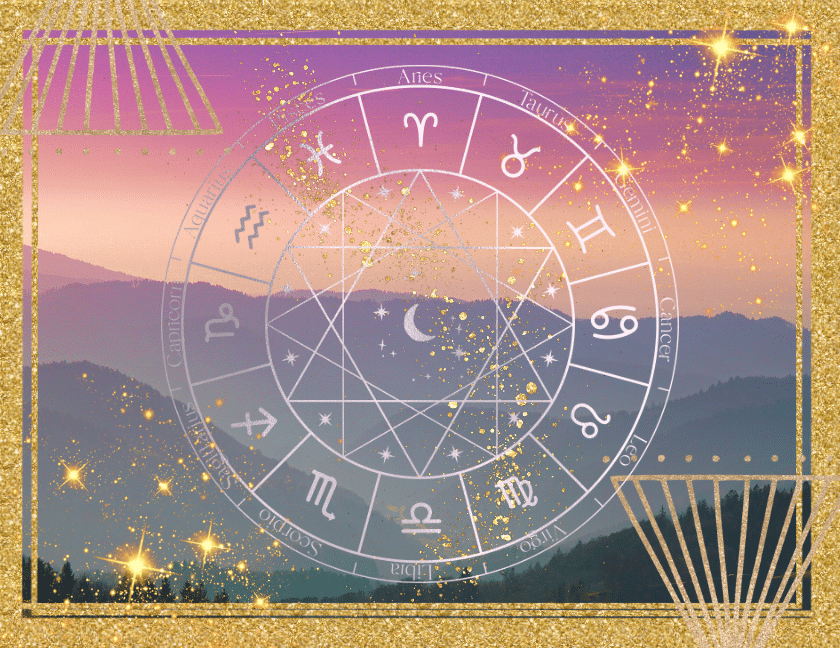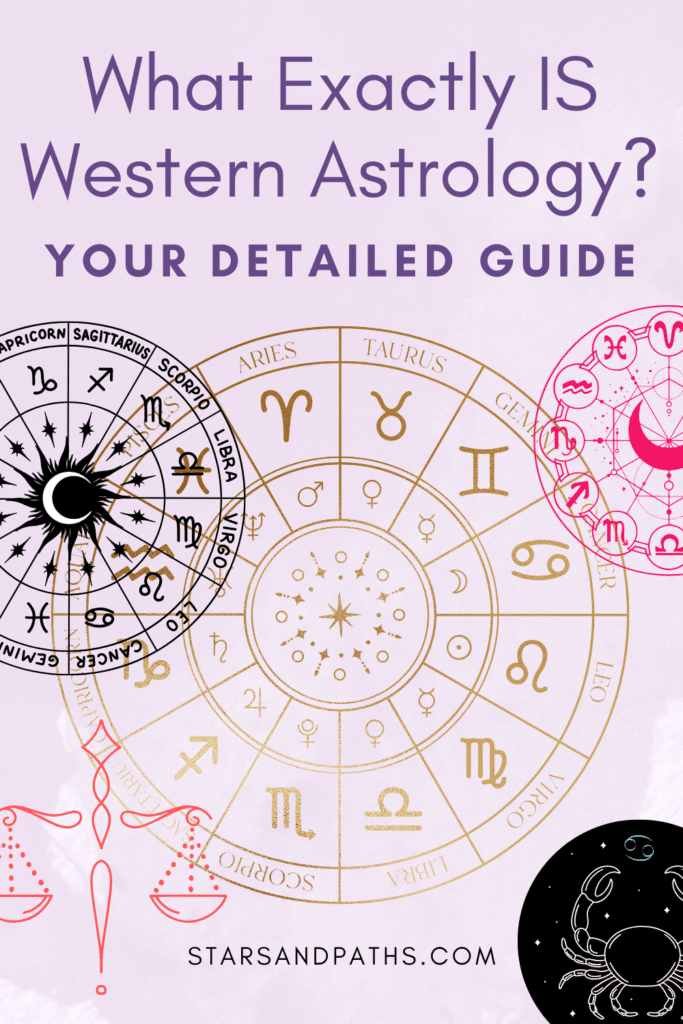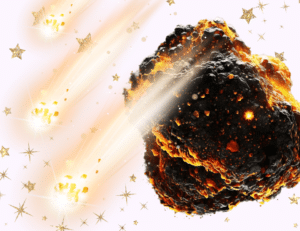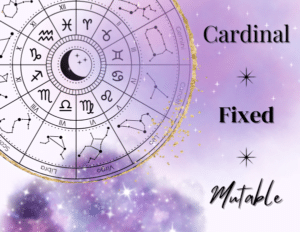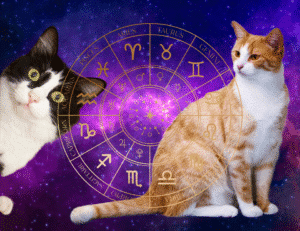The True Meaning and History of Astrology
There are many different forms of astrology dating back to ancient times. The forms most widely practiced today are:
- Vedic
- Chinese
- Western
Western astrology, having its roots in Mesopotamia around 4,000 years ago, is immensely popular in the West today. Personally, it’s my favorite and the one which I have spent the best part of my life informally studying.
Astrology, no matter its form, is defined as the study of the how the movement of the celestial bodies contained within our galaxy affect the people and events on Earth. It hypothesizes that the alignment of stars and planets at the time of one’s birth can influence their personality, thoughts, actions, interests, and overall life path. It’s also used for a variety of purposes, from making personal decisions, both large and small, to understanding world events.
I personally believe that each time we incarnate on Earth, a snapshot of the stars is imprinted upon us, influencing the type of personality we have. This new personality may be chosen with the help of our guides before incarnation. To me, this is what natal astrology really is.
The zodiac system, a key component of astrology, divides the celestial sphere into twelve equal parts, each named after the constellation that appears within it.
A constellation is a series of stars that were joined up long ago by the first astrologers in order to decipher what the signs would resemble in both physical appearance and nature. You can see many of the constellations in the night sky with various cell phone apps that map the Milky Way.
These days, I think it’s fair to say that nearly everyone knows what their star sign is and plenty can relate to the traits associated with it. And for many people, consulting their horoscope has evolved into an indispensable daily ritual that just cannot be neglected. Some people even plan their lives according to what their horoscope says, although I don’t really recommend that as it can diminish free will choice.
Horoscopes did do a marvellous thing for astrology fairly recently, though. The rise in their popularity can be largely attributed to the horoscopes that sporadically began appearing in women’s magazines, as well as newspapers, in the late 1800s and then regularly from the early 1900s until today. Since then, an ever-growing number of people have developed an interest in the subject, further contributing to astrology’s prominence today.
The Twelve Zodiac Signs
Each zodiac sign is associated with certain personality traits. For example, Aries is said to be fiery, impulsive, straight-forward, and confident. Leo is said to be warm-hearted, generous, bubbly and confident.
While each zodiac sign is clearly defined, it’s important to bear in mind that we’re all a mix of many different zodiac signs.
And that applies even if the Ascendant, Sun, Moon, Mercury, Venus and Mars are all in the same sign in your chart because the outer planets, asteroids, chart points, and the various different houses are still in play. And how the planets and other components of the birth chart are aspected further impact your chart.
Plus, rarely do we exhibit just the positive or just the negative traits associated with our Sun sign. Most of us behave well at times and not so well other times. Because of this, I wouldn’t pay too much attention to pop astrology, which is almost always Sun sign based!
The 12 Signs:
- Aries (March 21 – April 19)
- Taurus (April 20 – May 20)
- Gemini (May 21 – June 20)
- Cancer (June 21 – July 22)
- Leo (July 23 – August 22)
- Virgo (August 23 – September 22)
- Libra (September 23 – October 22)
- Scorpio (October 23 – November 21)
- Sagittarius (November 22 – December 21)
- Capricorn (December 22 – January 19)
- Aquarius (January 20 – February 18)
- Pisces (February 19 – March 20)
Please note that the date range is approximate as the dates change a little now and again.
Each sign is associated with a gender, modality, also referred to as quality, and an element, also referred to as triplicity.
In addition, there’s always at least one ruling planet associated with each sign. These classifications provide deeper insights into the traits associated with each sign.
The Genders
The masculine signs, also referred to as positive or extroverted signs, are the three air signs (Gemini, Libra, Aquarius), and the three fire signs (Aries, Leo, Sagittarius). These signs are associated with boldness. They’re externally focused and action-oriented. They’re believed to interact with the world in a more straight-forward, assertive way.
The feminine signs, also known as negative or introverted signs, are the three earth signs (Taurus, Virgo, Capricorn), and three water signs (Cancer, Scorpio, and the last sign in the zodiac system, Pisces). The feminine signs are typically characterized as introspective, receptive, empathetic, creative, and sensitive. They’re more internally focused, reflective, and responsive to their surroundings.
Please bear in mind that these astrological gender classifications don’t imply that certain signs should identify with certain genders. Astrology suggests that all individuals embody aspects of both masculine and feminine energies, regardless of their gender. These terms are more related to the traits and characteristics traditionally ascribed to each group.
The Modalities (or Qualities)
There are three different modalities in astrology:
- Cardinal
- Fixed
- Mutable
The Cardinal signs are: Aries, Cancer, Libra, and Capricorn. Cardinal signs are initiators. They correspond with the beginning of the four seasons and symbolize new beginnings and fresh starts. Characterized by their proactivity and drive, they are the trendsetters and the starters of the Zodiac.
They love to be first and set the agenda. They’re often full of energy, have a pioneering spirit, and are eager to lead and embark on new adventures of all kinds. Their main weaknesses are impatience or being too focused on initiation with a lack of follow-through. Through these signs, we learn about the importance and power of taking action, and starting new things including new relationships, jobs careers, and projects.
The Fixed signs are: Taurus, Leo, Scorpio, and Aquarius. Fixed signs fall in the middle of the seasons and are known for their stability, determination, and perseverance. They tend to be resistant to change and can be pretty stubborn at times. They align with the middle of each season and are associated with stability, persistence, and reliability. As their name suggests, fixed signs are often resistant to change and prefer consistency and predictability.
They are are like the foundational energy of the zodiac system, maintaining the momentum started by the Cardinal signs and laying the groundwork for the transformation brought by the mutable signs.
Their strong will and determination make them excellent at seeing projects through to completion. However, their resistance to change can sometimes mean stubbornness, fixed opinions, or inflexibility. These signs teach us the importance and power of resilience, determination, and prolonged focus.
The Mutable signs are: Gemini, Virgo, Sagittarius, and Pisces. These signs end each season. They stand for transition and completion.
These are the zodiac’s masters of transformation and evolution characterized by adaptability, flexibility, and the capacity to embrace change. They’re quick to change their thoughts, feelings, and actions according to their environment.
This flexibility often makes them versatile, open-minded, and willing to compromise. They love to experience new things of all kinds, and broaden their minds. However, they’re also known to be fairly fickle and indecisive due to their ever-changing nature.
The Elements
The four astrological elements are:
- Fire
- Earth
- Air
- Water
They symbolize specific temperaments and embody an individual’s foundational character traits and behavioral tendencies. They are, at least in my humble opinion, a particularly important part of astrology.
Fire signs: Aries, Leo, and Sagittarius. Fire signs are independent, effusive, courageous, confident, energetic, passionate, and lively. They mainly value situations, things and people that make them feel passionate and alive.
Earth signs: Taurus, Virgo, and Capricorn. Earth signs are practical, sensible, grounded, and reliable. They principally value material security, pragmatism, and hard work.
Air signs: Gemini, Libra, and Aquarius. Air signs are cerebral, sociable and communicative. They primarily value mental stimulation, interactions and relationships with others.
Water signs: Cancer, Scorpio, and Pisces. Water signs are intuitive, perceptive, emotional, and sensitive. They chiefly value compassion, empathy, kindness, and intuition.
Take a look at the graphic below to quickly identify the element, gender, and modality of each zodiac sign (I’m sorry about the soil looking a bit funny…!).
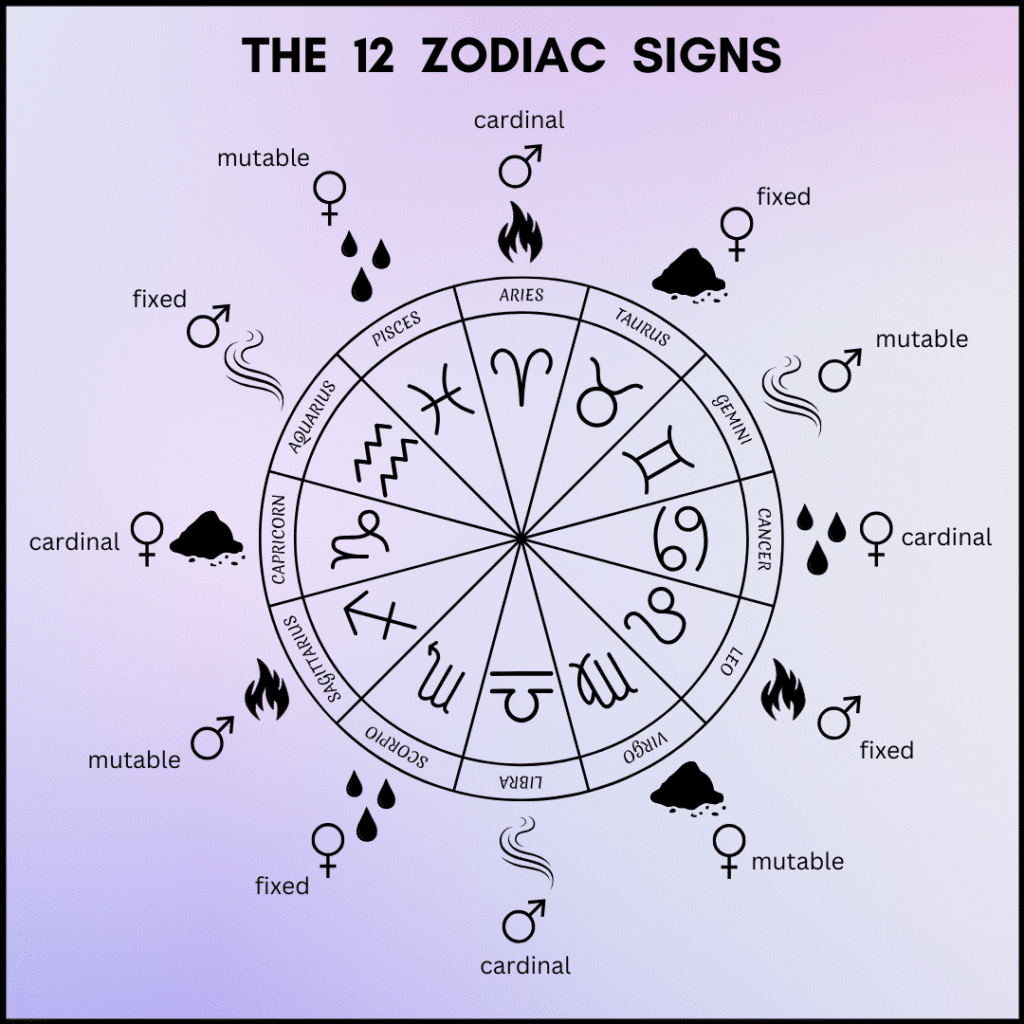
A Little About New Age Astrology
New Age astrology incorporates beliefs that are not commonly found in traditional astrology, for example, the law of attraction, karma, and reincarnation. A lot of young, professional astrologers, or astrology enthusiasts who create content for social media, frequently incorporate New Age beliefs in their work. And this is becoming increasingly common. Personally, I think this is the next stage of evolution for astrology.
The new understanding seems to run along the lines of the Soul being imprinted as it takes its first breath in its new body on the Earth plane. It receives a new personality and life plan as conditioned by the stars in their arrangement at the time of birth. A new personality is set for the fresh life along with a new life plan (made pre-birth on the other side with guides and other higher entities). All this can be seen within the chart.
The Soul needs to incarnate at a certain time to experience a particular personality, learn certain things and meet other Souls with whom it would like to work with, among other things. Everything occurs in divine timing and there is a reason why someone was born at the time they were born.
A Soul may choose to incarnate with a lot of one particular type of energy in their chart. For example, someone may choose Scorpio as their dominant sign. One of the reasons for this could be that they planned to experience a lot of challenging circumstances to learn and grow from because Scorpio heavily explores the theme of transformation. Or perhaps they chose to become a healer of some sort because Scorpio is also an emotional, empathetic, intuitive, and healing energy.
Common Misconceptions about Astrology
Misconception 1: There’s only one type of astrology practiced globally
No, there are MANY different forms that are practiced all over the planet. The most popular by far are:
- Vedic
- Chinese
- Western
Other forms include Mayan astrology.
Misconception 2: The Sun sign is all there is to it
People who don’t know much about astrology tend to think that the Sun sign is all that there is to astrology and that’s truly a load of irritating myth.
There is so much more to the birth chart than the Sun sign alone — the Rising and Moon signs are often considered equally important by many astrologers, including myself, but there are also many other things within the birth chart to consider.
So, while most people know what their Sun sign is, far fewer know what their birth chart looks like and how loaded with information about them it is. This is unsurprising considering how long and hard Sun sign astrology has been discussed in the media.
In reality, however, we are all a mix of many different signs. Someone’s personality might be nothing like their Sun sign says it should be. For instance, if someone’s Sun sign is Aries but the Moon, Ascendant, and Mercury are all in Pisces, they’ll undoubtedly have a rather Piscean personality!
Personally, as a Leo (Sun sign), while I can absolutely relate to many of the traits associated with Leo, I also strongly relate to the traits associated with my Mercury sign (Virgo), Moon sign (Aquarius), Rising sign (Gemini), the inter-planetary aspects in my chart, and much more besides!
Misconception 3: Horoscopes should ways be based on Sun sign instead of Rising sign
Another misconception is that horoscopes are most accurately written for the Sun sign. This just isn’t true. Most professional astrologers write horoscopes based on Rising sign. In fact, if you’re a graduate of the Faculty of Astrological studies in England, your qualification could be revoked for writing horoscopes by Sun sign!
Misconception 4: It’s the same as Astronomy
Another fairly common misconception is that astrology is the same as astronomy. It’s not. It’s very different! While both subjects focus on the study of celestial bodies, astronomy is a scientific study of celestial bodies and astrology is based on the belief that the positions and movements of them impact the personality traits and behavior of humans. So, they’re vastly different.
Also, one is considered a scientific field of study and the other a woo-woo hobby at best by much of society — for the time being, anyway…
Misconception 5: It has never been taken seriously by academics
Until 1890, you couldn’t study medicine without studying astrology— it was considered that important back then!
Misconception 6: It’s a pseudoscience
Astrology is actually classified as a metaphysical or spiritual practice, and not a pseudoscience.
This content, like all content on Stars & Paths Astrology, is entirely human-made. Please feel free to bookmark and share.

